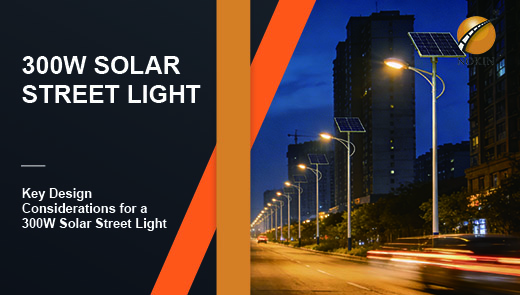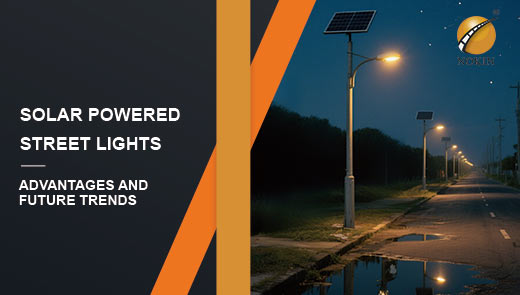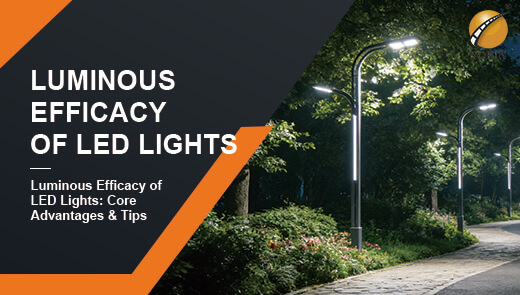Why Are Most Solar Street Lights In Cities Yellow?
Walking in the streets and alleys of the city, when night falls, warm and soft yellow light pours out from the solar street lights, illuminating the way home for pedestrians. Why do most solar street lights in the city choose to emit yellow light? There are profound scientific principles, significant practical advantages and comprehensive considerations for the overall development of the city behind this. Next, we will analyze this phenomenon in all aspects and in depth to uncover the mystery of the popularity of yellow solar street lights.
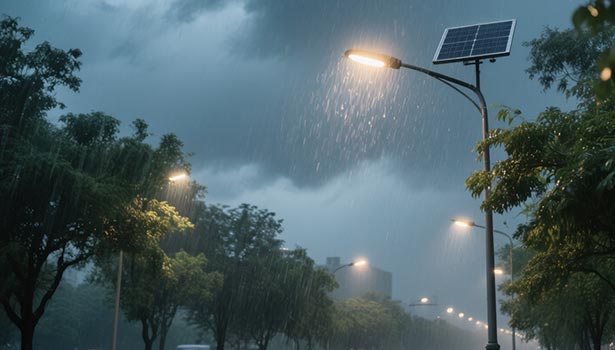
Advantages of Solar Street Lights That Emit Yellow Light
Energy-Saving and High-Efficiency
At a time when energy is becoming increasingly scarce and environmental awareness is increasing, energy-saving and high-efficiency have become important considerations for urban infrastructure construction, and solar street lights that emit yellow light have shown great advantages in this regard.
Yellow and orange LED lights are very energy-efficient. Compared with ordinary street lights, they consume much less power. This is mainly due to their unique light-emitting mechanism and lower power requirements. Relevant research data shows that under the premise of achieving the same lighting effect, the energy consumption of solar street lights that emit yellow light is only 1/10 of that of traditional incandescent lamps, and it can also save 20% - 30% of electricity compared with ordinary LED street lights. This significant energy-saving effect means that the city's expenditure on street lamp electricity consumption will be greatly reduced.
Long Service Life
In addition to energy saving, solar led street lights that emit yellow light also have a longer service life. Traditional street lamps, such as high-pressure sodium lamps, need to be replaced every 1.5 years on average. Frequent replacement not only increases maintenance costs, but also consumes manpower and time. The service life of solar street lights that emit yellow light can be as long as 5-10 years, which means that for several years, the city does not need to invest too much energy and money in the replacement of street lamps. At the same time, its maintenance frequency is also greatly reduced, further saving maintenance costs.
Environmentally Friendly and Sustainable
From an environmental perspective, the advantages of solar street lights that emit yellow light are also obvious. Lower energy consumption means reduced dependence on traditional energy sources such as coal and natural gas in the power generation process, thereby reducing the emission of pollutants such as carbon dioxide and sulfur dioxide. In addition, solar LED street lights are more environmentally friendly during production and recycling. They do not contain harmful substances such as mercury and lead, and will not pollute soil and water sources. This dual advantage of economy and environmental protection makes solar street lights an ideal choice for cities to achieve sustainable development.
Create A Comfortable Atmosphere
Light is not only a tool to illuminate the road, but also an important element to shape the city's atmosphere. The yellow light emitted by solar street lights creates a warm, comfortable and vibrant night environment for the city.
This comfortable atmosphere also has a positive effect on people's outdoor activities and social interactions. Warm lights attract residents to walk out of their homes and communicate in public spaces such as streets and parks. In the square of the community, people sit together and talk; on the benches in the park, couples snuggle to enjoy the night view. Yellow lights promote connections between people, enhance the cohesion of the community, and make the city's night full of life and human touch. At the same time, for the city's commercial activities, the warm lighting environment can also attract more consumers to stop and drive the development of the night economy.
Protecting Sleep and Visual Health
In modern life, people's health issues are increasingly concerned, and the impact of light on health is gradually recognized by people. Solar street lights that emit yellow light have unique advantages in protecting people's health, especially in terms of sleep quality and visual health.
Studies have shown that under warm LED lights of about 3000K, the human eye can maintain a good dark adaptation time. Good dark adaptation means that even when traveling at night, people's eyes can quickly adapt to environmental changes and will not be affected by the light of street lights. The quality of subsequent sleep will not be affected. When you wake up the next day, you will feel more energetic and can devote yourself to work and life in a better state.
In addition, the soft characteristics of yellow light are also very beneficial to people's visual health. It does not cause strong stimulation to the eyes like strong light, reducing the occurrence of problems such as eye fatigue and dryness. Whether walking under yellow light for a long time or driving by, people's eyes can remain comfortable.
Reduce Interference with Wild Animals
Cities are not only human homes, but also habitats for many wild animals. Many wild animals rely on natural light and their own biological clocks to forage, reproduce, migrate, and other behaviors when they are active at night. Bright lights can disrupt their biological clocks, disorient them, and even threaten their survival. In contrast, yellow and orange lights are softer and less disruptive to wild animals. Their lower brightness and specific spectral range will not strongly stimulate the visual system of wild animals, nor will they seriously interfere with their natural behavior.
In some cities' wetland parks and nature reserves, the use of solar street lights that emit yellow light has significantly reduced the impact on the activities of wild animals such as birds and insects, and the ecological environment has been better protected. This not only helps to maintain biodiversity, but also adds more natural vitality to the city.
Guarantee of Excellent Visibility
The weather is unpredictable. In severe weather conditions such as fog, rain, and snow, the lighting effect of solar street lights is directly related to people's travel safety. With its unique optical properties, solar street lights that emit yellow light have shown excellent performance in these special weather conditions, providing reliable protection for people's travel.
|
Weather Conditions |
Yellow Light Performance |
White Light Performance |
|
Fog |
Strong penetration, less scattering, high visibility; effectively reduces the risk of accidents caused by unclear vision |
Weak penetration, more scattering; prone to glare; seriously affects visibility and increases the likelihood of traffic accidents |
|
Rainy |
Soft light, less likely to cause road reflection interference; comfortable for drivers and pedestrians; enables clear observation of road conditions |
High brightness may cause significant visibility reduction due to road reflection; makes it difficult for drivers to distinguish between roads and vehicles |
|
Snowy |
Better road illumination; reduces light reflection on snow; lessens visual fatigue and ensures travel safety |
Strong light may cause strong snow surface reflection; affects driver's vision; increases driving difficulty and risk factor |
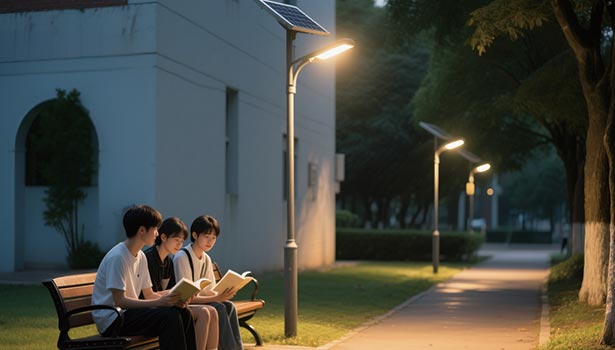
Comparison with White Light Street Lights: Reasonable Choice under Different Needs
Although solar street lights that emit yellow light have significant advantages, white light street lights also have their unique application scenarios in urban lighting. Understanding the characteristics and scope of application of both will help cities make more reasonable decisions on street light selection.
Advantages of White Solar Street Lights
White light is often combined with LED technology, and with its high brightness and clarity, it has a place in urban lighting. In busy traffic areas, such as urban main roads and intersections, white light can significantly improve visibility and ensure the safe passage of pedestrians and vehicles. Its high color temperature (usually 4000K - 6000K) simulates the effect of daylight, allowing people to observe road conditions, traffic signs and details of the surrounding environment more clearly.
In addition, white light can enhance the sense of security in urban environments and reduce the occurrence of criminal behavior. Bright light makes it difficult for criminals to hide, increasing the difficulty and risk of them committing crimes. At the same time, white light can highlight architectural features, public art and landscape design, and enhance the visual appeal of cities at night. Some modern urban landmark buildings, under the illumination of white lights, show unique charm, attracting a large number of tourists to come and watch, promoting the development of tourism and economic prosperity.
Considerations for Cities to Choose Street Lights
When choosing solar street lights, cities need to consider multiple factors comprehensively.
Durability
To ensure that solar street lights can operate stably in various environments and weather conditions, you need to choose solar street lights with a high protection level to withstand bad weather. For example, in coastal areas, street lights need to have good salt spray corrosion resistance; in cold areas, street lights must be able to adapt to low temperature environments.
Energy saving
Energy saving is one of the important conditions for choosing solar street lights. In order to reduce energy consumption costs, it is recommended that you give priority to energy-saving lamps such as LEDs, which can save you a lot of costs in the long-term operation process.
Environmental impact
How the lighting system promotes sustainable development and reduces the impact on the environment is also an important consideration for modern cities to choose lamps. Solar street light manufacturers recommend that you choose environmentally friendly and pollution-free products to reduce damage to the ecological environment.
Demands for Different Usage Scenarios
Different usage scenarios, the choice of solar street lights is also different. For example, in areas such as city centers that require high brightness and safety, white solar street lights may be more suitable; while in rural or foggy areas, solar street lights that emit yellow light can better play their advantages. In addition, some specific places, such as hospitals and around schools, have high requirements for the comfort and health of lighting, and solar street lights that emit yellow light may be a better choice. Cities should reasonably match yellow and white light according to their actual needs and characteristics to achieve the best lighting effect and social benefits.
FAQs About Solar Street Lights That Emit Yellow Light
Why are some solar street lights that emit yellow light replaced?
White LED street lights have replaced yellow HPS technology with advantages such as energy saving, long life and flexible lighting control. Its application not only reduces maintenance costs, but also reduces light pollution, making it a popular choice for solar street lighting. However, it should be noted that solar street lights that emit yellow light are not completely gone and still play an important role in specific scenarios.
Are solar street lights that emit yellow light better in foggy days?
Yes. Yellow light has a longer wavelength, is less scattered in fog, and produces less glare, which can effectively improve the driver's visibility, so it performs better in foggy days. Related research and practical applications have proved the important role of solar street lights that emit yellow light in ensuring traffic safety in foggy days.
Are white LED street lights more likely to produce glare than yellow ones?
Because white LED lights have high color temperature and high intensity, they are theoretically more likely to produce glare. However, with the development of technology, modern LED lighting has been equipped with a variety of components to reduce glare, such as special optical design, sunshade, etc., which has effectively alleviated this problem. However, in some white LED street lamp application scenarios that do not use anti-glare technology, the glare problem still exists.
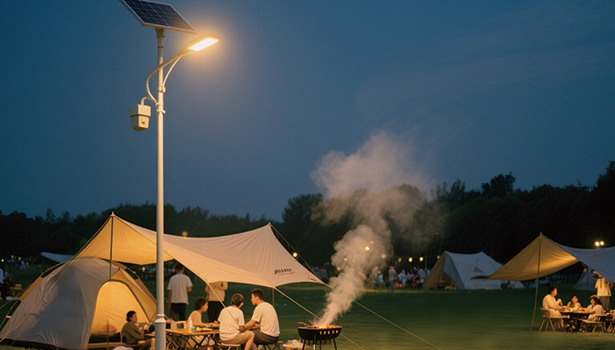
Conclusion
Yellow light have many advantages in urban lighting, such as energy saving and high efficiency, creating a comfortable atmosphere, health and friendliness, reducing interference with wild animals, and excellent performance in special weather. These advantages are of great significance to improving the quality of life of residents, protecting the environment, maintaining ecological balance and ensuring travel safety.
However, with the advancement of technology, white LED street lights have also occupied a place in urban lighting with their own advantages in brightness, color rendering index and versatility. In the selection of street lights, cities should not simply choose one or the other, but should comprehensively consider actual needs, application scenarios and various factors, and reasonably match yellow and white light. Through scientific planning and selection, the advantages of solar street lights of different colors can be fully utilized to achieve the best lighting effect and social benefits, so that the night of the city is bright and safe, warm and pleasant, and provide strong guarantees for the sustainable development of the city and the happy life of residents.

